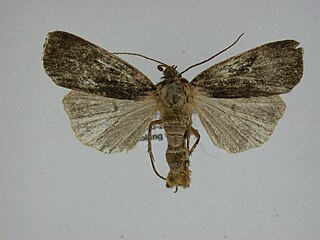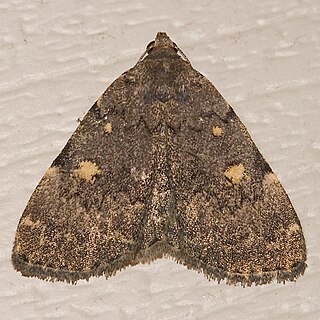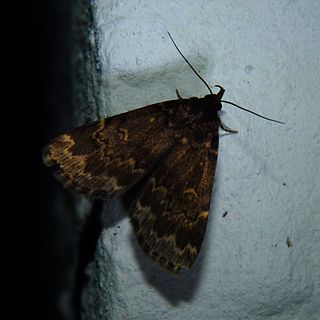
Banksia aemula, commonly known as the wallum banksia, is a shrub of the family Proteaceae. Found from Bundaberg south to Sydney on the Australian east coast, it is encountered as a shrub or a tree to 8 m (26 ft) in coastal heath on deep sandy soil, known as Wallum. It has wrinkled orange bark and shiny green serrated leaves, with green-yellow flower spikes, known as inflorescences, appearing in autumn. The flower spikes turn grey as they age and large grey follicles appear. Banksia aemula resprouts from its woody base, known as a lignotuber, after bushfires.

Schinia, commonly called flower moths, is a large genus of moths belonging to the family Noctuidae. The genus has a Holarctic distribution with the vast majority of species being found in North America, many with a very restricted range and larval food plant.

Idia is a genus of litter moths of the family Erebidae first described by Jacob Hübner in 1813.
Abagrotis orbis, the well-marked cutworm or Barnes' climbing cutworm, is a moth of the family Noctuidae. The species was first described by Augustus Radcliffe Grote in 1876. It is in southwestern North America, extending eastward across the plains and with a large disjunct population in dune habitats in the southern Great Lakes area. It extends into western Canada only in the southern interior of British Columbia and southern Alberta and Saskatchewan.

Pseudohermonassa bicarnea, the pink-spotted dart, is a moth of the family Noctuidae. The species was first described by Achille Guenée in 1852. It is found in eastern North America, and as far west as south-central Saskatchewan and central North Dakota, south to western North Carolina. It has recently been recorded from Tennessee.
Xestia normaniana, or Norman's dart, is a moth of the family Noctuidae. The species was first described by Augustus Radcliffe Grote in 1874. It is found in North America from Nova Scotia across southern and central Canada to Alberta. In the eastern United States it ranges from Maine to eastern Minnesota, and south along the Appalachians to western North Carolina. It has recently been recorded from Tennessee.
Euxoa dargo is a moth of the family Noctuidae first described by Strecker in 1898. It is found in North America from south-eastern Manitoba west to the southern interior of British Columbia, south to Oregon, southern Idaho and northern New Mexico, and east to eastern South Dakota.

Idia aemula, the common idia, powdered snout or waved tabby, is a litter moth of the family Erebidae. The species was first described by Jacob Hübner in 1813. It is found from Canada south to Florida and Texas. It has been reported in the Palearctic.

Idia lubricalis, the glossy black idia, is a litter moth of the family Erebidae. The species was first described by Carl Geyer in 1832. It is found from Canada south to Florida and Texas in deciduous forests.
Idia occidentalis is a species of litter moth of the family Erebidae first described by Smith in 1884. It is found in North America from southern Alberta and British Columbia, south to Colorado, Arizona and California.

Idia americalis, the American idia or American snout, is a litter moth of the family Erebidae. The species was first described by Achille Guenée in 1854. It is commonly found in moist forests in North America, ranging from southern Canada to Florida and Texas. It is nocturnal and can be lured by sugar baits and light traps.

Idia diminuendis, the orange-spotted idia, is a litter moth of the family Erebidae. The species was first described by William Barnes and James Halliday McDunnough in 1918. It is found in North America from Wisconsin to Nova Scotia, south to Florida and Texas.

Idia forbesii, or Forbes' idia moth, is a litter moth of the family Erebidae. The species was first described by George Hazen French in 1894. It is found in North America from Wisconsin to Quebec, south to Florida and Texas.
Idia julia, or Julia's idia, is a litter moth of the family Erebidae. The species was first described by William Barnes and James Halliday McDunnough in 1918. It is found from southern Canada south to Georgia and Texas.

Idia rotundalis, the chocolate idia or rotund idia moth, is a litter moth of the family Erebidae. The species was first described by Francis Walker in 1866. It is found from southern Canada to Florida and Texas.
Idia scobialis, the smoky idia, is a litter moth of the family Erebidae. The species was first described by Augustus Radcliffe Grote in 1880. It is found in North America from Michigan, southern Quebec and Maine, south to Florida and at least Kentucky.
Idia denticulalis, the toothed idia, is a litter moth of the family Erebidae. The species was first described by Leon F. Harvey in 1875. It is found in Quebec, Canada, and the US from Wisconsin to New England, south to Alabama and Texas.
Idia laurentii, the laurentine idia, is a litter moth of the family Erebidae. The species was first described by J. B. Smith in 1893. It is found in the US from central New York, south to the mountains of North Carolina.
Idia majoralis, the greater idia, is a litter moth of the family Erebidae. The species was first described by J. B. Smith in 1895. It is found in Canada from Ontario and Quebec, south into the United States, where it has been recorded from Illinois, Wisconsin and Missouri.
Idia immaculalis, the immaculate idia, is a litter moth of the family Erebidae. The species was first described by George Duryea Hulst in 1886. It is found in North America from at least California, north and east across Montana to southern Alberta and Saskatchewan.










